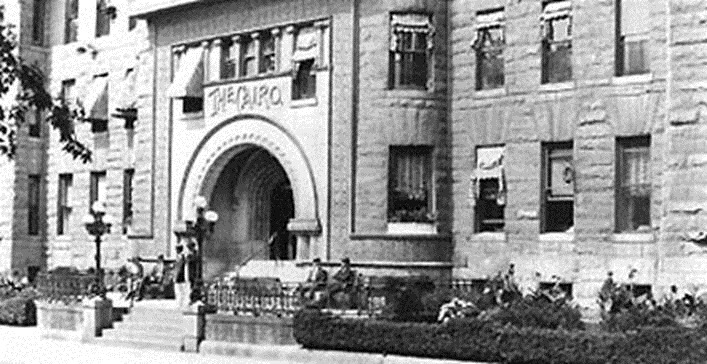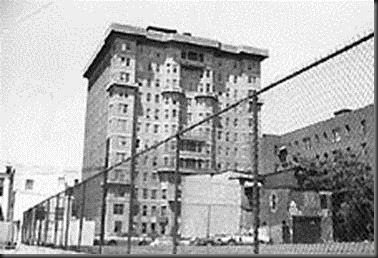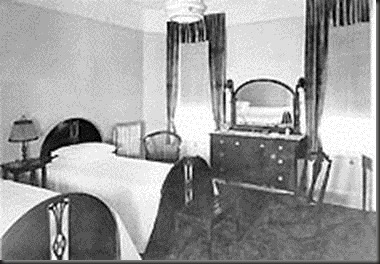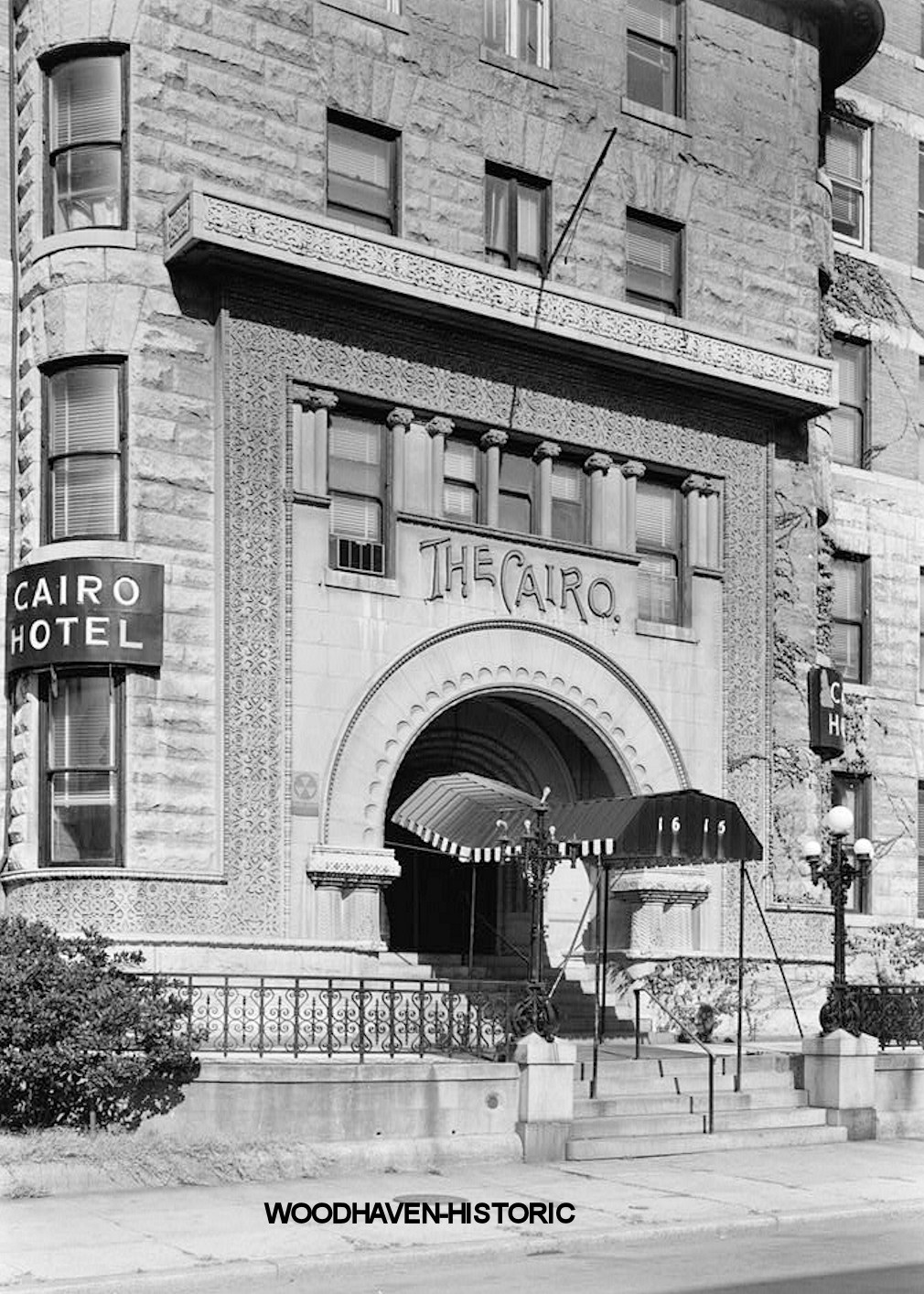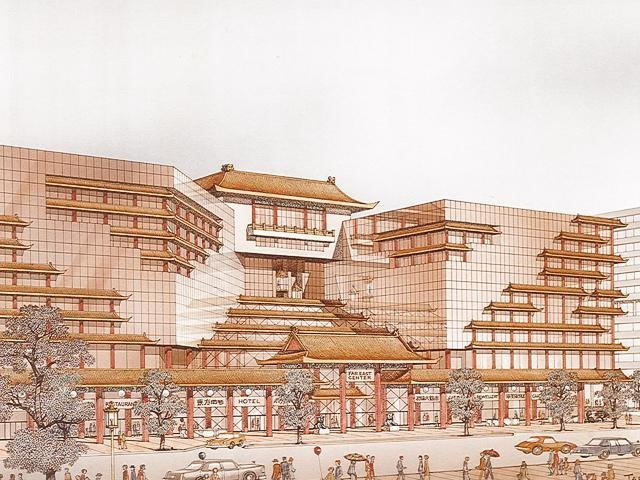Republished from High Times by WILL DOIG on January 9, 2003
When Arthur Cotton Moore first pulled up to The Cairo in 1974, two men were carrying a corpse out the front door as casually as if they were moving a couch. No yellow crime scene tape cordoned off the area, no detectives took statements. The anonymous body being toted down the stately front staircase hardly garnered a second glance.
The Cairo spurred Washington’s building height limit and remains the city’s tallest residential structure.
A crumbling tower in a dying neighborhood, The Cairo was just another pile of bricks, indistinguishable from its neighbors except for its dramatically imposing height. Moore, a noted local architect, had been hired to make The Cairo livable again. When he arrived that day, the twelve-story building had just turned eighty years old.
It was hard for Moore to believe that this decaying deathtrap was once The Cairo Hotel, the jewel of high society Washington and a magnet for visiting celebrities. By ’74, the once glamorous address was inhabited by drifters, hookers and junkies, all living among herds of rats, caving floors, and desiccated opulence.
“It was almost as if it were haunted, ” says Moore of that initial visit. “Hard to believe it was once called the Plaza of Washington. ”
Today, while the exterior looks basically the same, the interior is nothing like what it once was. When renovations began in the mid-Seventies, The Cairo had fallen so far that it had to be gutted. The nymph-topped fountains and Romanesque columns in the lobby were torn out and replaced with sensible condominiums, neither glamorous nor gritty, with cream-colored walls and track lighting. The Cairo became the earnest condominium complex it is today, easily marketable to Dupont Circle’s emerging yuppie populace.
D.C.’s love/hate relationship with The Cairo began with its grand opening in 1894.
“It is a box full of holes, ” decried Architectural Record, deploring its formidable Moorish design. Neighbors saw it as intrusive, tacky and dangerous. The city viewed its height — taller than the churches — as arrogant. Even the building’s architect/owner, Thomas
Franklin Schneider, was considered annoying.
Schneider had returned from the 1893 Chicago World’s Fair with a vision: Washington, D.C.’s first residential skyscraper, designed in the image of the Fair’s “Transportation Building. ” Featuring a dramatic Egyptian Revival arch at the entrance and sharp cornices, the Transportation Building, located on Cairo Street at the Fair, became the blueprint for Schneider’s project.
The Cairo was — and still is — taller than any other apartment building in Washington. Water and ladders from fire trucks could not reach the upper floors in case of a fire, and neighbors were concerned that the building might blow over in a strong wind, so the city conducted wind tests on the structure to prove its integrity. Still, its ghoulish veneer and scowling gargoyles were considered a blight on the neighborhood, enough so that in 1894 D.C.’s Board of Commissioners enacted the building height limit to prevent another Cairo from ever happening again. The height limit law prompted by the Cairo remains on the books to this day, and is the reason why Washington, D.C. is the only major American city that doesn’t boast a skyline.
Over time, Dupont got used to The Cairo, which became The Cairo Hotel around the turn of the century. It wasn’t so much that the Cairo caught up with the times as the times seemed to catch up with it. Its lavish ornamentation, over-the-top style and dramatic curves made it the perfect ritzy, glitzy magnet for the early 20th century’s rich and fabulous.
On the street out front, women in sable fur wraps, white gloves and bobbed hair stepped out of boxy, spoke-wheeled Cadillacs and horse-drawn buggies, escorted by men in satin top hats. The Cairo’s steps were an endless cascade of coattails and sleeveless gowns. The soaring arched entrance, like a yawning mouth, gave even the most casual arrival an air of grandeur.
The vast lobby was anchored by a fountain surrounded by pillars of fleur-de-lis. Blank-eyed statuettes of Greek sprites gawked at the velvet settees and Victorian chairs. A phonograph might have been crackling out the latest from Al Jolson or Louis Armstrong. The ambiance dripped of Prohibition-era intrigue, right down to the dim, dusty-blond beaded lampshades. It was the type of lobby where expatriates would have held hushed conversations with foreign ambassadors, where great writers would have scribbled rough drafts, and where eccentric inventors would have pondered their next gizmo over a highball of bootleg gin.
Next to the lobby was the Oriental Room, a parlor designed to feel British-Indian, as well as a ballroom for black tie affairs and functions. An English basement contained a billiard room and a bowling alley. But the centerpiece was a Hitchcockian marble staircase that swirled all the way up to the top floor, so that one could look down through the middle and see straight to the lobby from a vertigo-inducing twelve stories.
For the first half of the 20th century, when being a socialite really meant something, the socialites of the world would congregate at The Cairo Hotel when in Washington. The Willard and The Mayflower had their Presidential parties and uber-wealthy fat cats, but The Cairo had a more shadowy kind of glamour. It was Casablanca meets Cleopatra, and attracted guests who appreciated a little dark poetry with their stay. Guests like F. Scott Fitzgerald and Thomas Edison (who must have appreciated the electric lights — still a rarity when The Cairo was built).
Unfortunately, like many of The Cairo’s treasures, the guest registries were lost when the building began its steady decline. After World War II, the baby boom sent families flocking to the suburbs, and the District of Columbia, like many cities, began to waste away as its population fled. When The Cairo could no longer turn a profit, Schneider’s daughters were forced to sell it for three million dollars. That was 1955. The building would spend the next seventeen years caving in on itself from neglect. During this time, its columns crumbled and its fountains ran dry, but it was far from vacant. Squatters and drug dealers took over the building, the ballroom was seized upon for clandestine drag shows, and an outcall prostitution service sprang up at the switchboard.
The Cairo was back in business.
“It was a fleabag, ” says Diana McLellan, applying a brand of lipstick called Wet and Wild while she speaks. McLellan, who turned 65 in September, proudly shows off her new Medicare card. She’s eagerly anticipating prime seating on the Metro.
“They assume you’ll be too bloody miserable by this age to enjoy it, ” she laughs in a high British accent.
In the early ‘60s, before her stint as, among other things, a popular gossip columnist for The Washington Star, an editor at The Washingtonian, and, most recently, author of The Girls: Sappho Goes to Hollywood, McLellan landed a job as the switchboard operator for The Cairo. By that time, the management was renting out rooms to a much different sort of clientele for the cut rate of around three dollars per night.
“The manager was this foul, gum-chewing guy who called me ‘baby’, ” recalls McLellan. “When he hired me, he asked me if I stole. I told him that I wouldn’t tell him if I did, and what was there to steal from this fleabag anyway? ”
Still, because so many of the guests were drug addicts, the manager kept a snarling bulldog in his office to discourage theft. His wife, an attractive, slender woman who worked for Brazilian Varig Airlines, left him during McLellan’s tenure.
“I think he became alcoholic, ” says McLellan.
McLellan worked the switchboard from 7 a.m. to 3 p.m., at which time she was relieved by Melody. Pink-skinned, blond, and roughly two hundred pounds, Melody was one of The Cairo’s resident hookers. McLellan, then 22, learned a lot from their conversations.
“She’d say to me, ‘Oh, Room 601, he likes it with kneepads and a spoon.’ Once she let me listen in on the line while she was soliciting business. I was wildly curious. ”
The informal “dating service ” was run by the bellboys, a “feral, evil sort of bunch ” who mostly hung around the lobby and frightened people. Adding to the sexual carnival, The Cairo became a popular spot for nooners. Couples, both legit and illicit, created a miniature boom in business during lunch hour each day.
The basement, where tuxedo-clad men once bowled a few frames or shot a game of pool, became a “screaming room ” for the hordes of youth who would pour into town to hawk magazine subscriptions on the street. By day, these kids hobbled out to Dupont Circle with crutches, eye patches, any handicap they could feign to garner pity from passers-by and make a sale. By night, they would swarm back to The Cairo “like locusts, ” says McLellan, and hold their motivational rallies in the basement, “chanting and screaming feverishly down below. ”
But The Cairo’s guests weren’t all howling junkies and secretaries shrieking in their bosses’ arms. The building absorbed a steady stream of what McLellan calls “the Willy Lomans of the world, ” brown-suited traveling salesmen who would shuffle in on a waft of failure and quietly adjourn to their rooms with a briefcase that was as likely to contain a flask of scotch as it was pencils or documents.
And of course, there was the obligatory crazy old lady who would wander the halls, walking stick in hand. She had lived there since the building’s heyday and wasn’t about to vacate just to accommodate the new riffraff. But this particular resident’s name was Mrs. Corcoran — arguably the most powerful name in the Washington arts scene. Looking back, it seems fitting that even The Cairo’s resident relic should be one of monumental influence.
“She must have been about 85, ” says McLellan. “A dignified little old lady who would totter around on her skinny little legs, and at night go down to the ballroom and get plastered. Sometimes this distinguished looking colonel would come to escort her. She was a rare holdover from the old days. ”
“It wasn’t much to look at, but it was a place that had a stage where we could go and not be hassled, ” says Carl Rizzi, a.k.a. “Mame Dennis, ” President of the Academy of Washington. “In those days, none of the hotels would accept us. ”
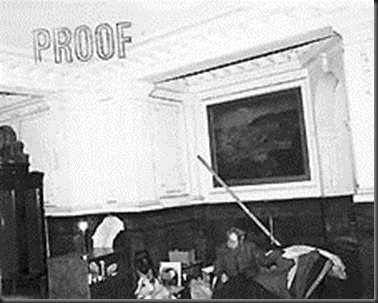
An old woman and her dog had taken up residence in the dilapidated lobby when architect Moore arrived in 1974.
“The building was sleazy, ” recalls Rizzi. “There were prostitutes and drug dealers and God knows what else going on in that lobby. But they didn’t bother us and we didn’t bother them. We were just thankful to have a place to go. ”
Once grand, the ballroom had decayed significantly, but “Liz Taylor, ” the Academy’s president at the time, “did what she could to make it look nice, ” says Rizzi.
“You had to dress to the nines. She insisted on it. The men wore tuxedos and we wore gowns and gloves. If you came to the door not looking right, she wouldn’t let you in. She didn’t give a damn who you were. ”
This effort to bring a sense of dignity to The Cairo’s functions had its slapstick moments. Rizzi remembers female impersonators lifting their gowns above the bathroom floor, covered in water from overflowing toilets. And one year the Miss Universe ball was brought to a halt by a brigade of firefighters.
“They came storming through, hoses and all, ” says Rizzi. “We just waited till they passed and then started up again. ”
Such elegance in the midst of such squalor amused the other guests, who never gave the Academy much trouble. It was as if the overriding common bond that kept everyone amicable was their shared status as outsiders.
“I think they just liked looking at us, ” says Rizzi. “We thought we were very grand back then. In its day, The Cairo must have been quite grand as well. But when other hotels wouldn’t deal with us, they would. Evidently the owner just wanted money. ”
| One year the Academy’s Miss Universe ball was brought to a halt by a brigade of firefighters. “They came storming through, hoses and all, ” says Carl Rizzi, a.k.a “Mame Dennis. ” “We waited till they passed and then started up again. “ |
 It would be only a mild exaggeration to say that by 1974 the interior of The Cairo represented what the world might look like five years after the apocalypse. Wild dogs roamed the hallways, defecating and terrorizing those who had dared to remain. Vandals had destroyed most of the building’s antiques. The heat had been shut off, and many windows were broken. By this point, the owner had completely abandoned the building. The Cairo was rotting away, and taking its residents down with it.
It would be only a mild exaggeration to say that by 1974 the interior of The Cairo represented what the world might look like five years after the apocalypse. Wild dogs roamed the hallways, defecating and terrorizing those who had dared to remain. Vandals had destroyed most of the building’s antiques. The heat had been shut off, and many windows were broken. By this point, the owner had completely abandoned the building. The Cairo was rotting away, and taking its residents down with it.
“It was a one-building crime wave, ” says Arthur Cotton Moore of the first day he arrived at the site. “Even as the process of selling it was taking place, there were people who refused to leave still holed up inside. ” One of these people was a territorial old woman who lived in the lobby with a dog at her side.
But as much as the dogs unnerved Moore, the structure itself worried him most of all. Rather than dispose of its garbage, the building’s management had simply piled it all in the basement over the years. During that time, the refuse had turned to acid, which had eaten away at the steel supports.
“This tallest building in Washington seemed to be sitting on a small pile of rust, ” says Moore. “The whole thing could have collapsed. ”
To make matters worse, the construction superintendent already gutting the building was incompetent. Someone had literally driven a bulldozer in, flattening everything in their path. New drywall was installed and then the roof was torn off, ensuring that the first heavy rain would ruin all of the new drywall — which, of course, it did. The valuable marble doorknobs quickly disappeared from their sockets and were most likely pawned. And to ice the cake, the construction superintendent was arrested on drug charges and taken to jail in Atlanta — though he returned when the construction was completed, in shackles, to lecture about the building’s newfound integrity.
Needless to say, the project was unpopular. The staff was repeatedly harassed by the remaining residents and cornered by snarling dogs. In the end, little could be salvaged. The interior was picked clean and rebuilt from scratch.
The new Cairo lobby in the ‘70s following the renovations.
You could say that The Cairo’s metamorphosis into an unstriking condominium complex reflects the Ikeafication that’s taken place in Dupont Circle as a whole. The staid lobby walls now boast photographs of The Cairo Hotel of old, underlining the transformation by literally placing the past and the present back to back. A glimpse of one of the condo units is inevitably a disappointment. Rather than Queen of the Nile mystique, you’re confronted with austere angles and climate control.
At the very least, the exterior remains a peculiar spike rising above a cityscape whose growth was stunted ninety years ago because of the very building that looms over it today. Today’s Cairo is home to enough gay residents to have earned the nickname The Queero, and in a way, its rise to fabulousness and fall to the gutter make it a quintessential gay icon. It may as well be a Tallulah or Judy, with a career that started out glamorously and crashed spectacularly after one too many martinis. You can see The Cairo now, finally sedate, kicking back at the end of a turbulent career that seethed with more drama than most Washingtonians ever dream of.

